Human Biology Study Material
VerifiedAdded on 2022/12/27
|10
|2325
|59
AI Summary
This study material provides information on various topics related to Human Biology, including cell biology, genetics, digestion, metabolism, and more. It covers both theoretical concepts and practical applications. The content includes multiple-choice questions, explanations, and examples to help students understand the subject better. Whether you need study material for exams or assignments, Desklib offers a wide range of resources to support your learning.
Contribute Materials
Your contribution can guide someone’s learning journey. Share your
documents today.
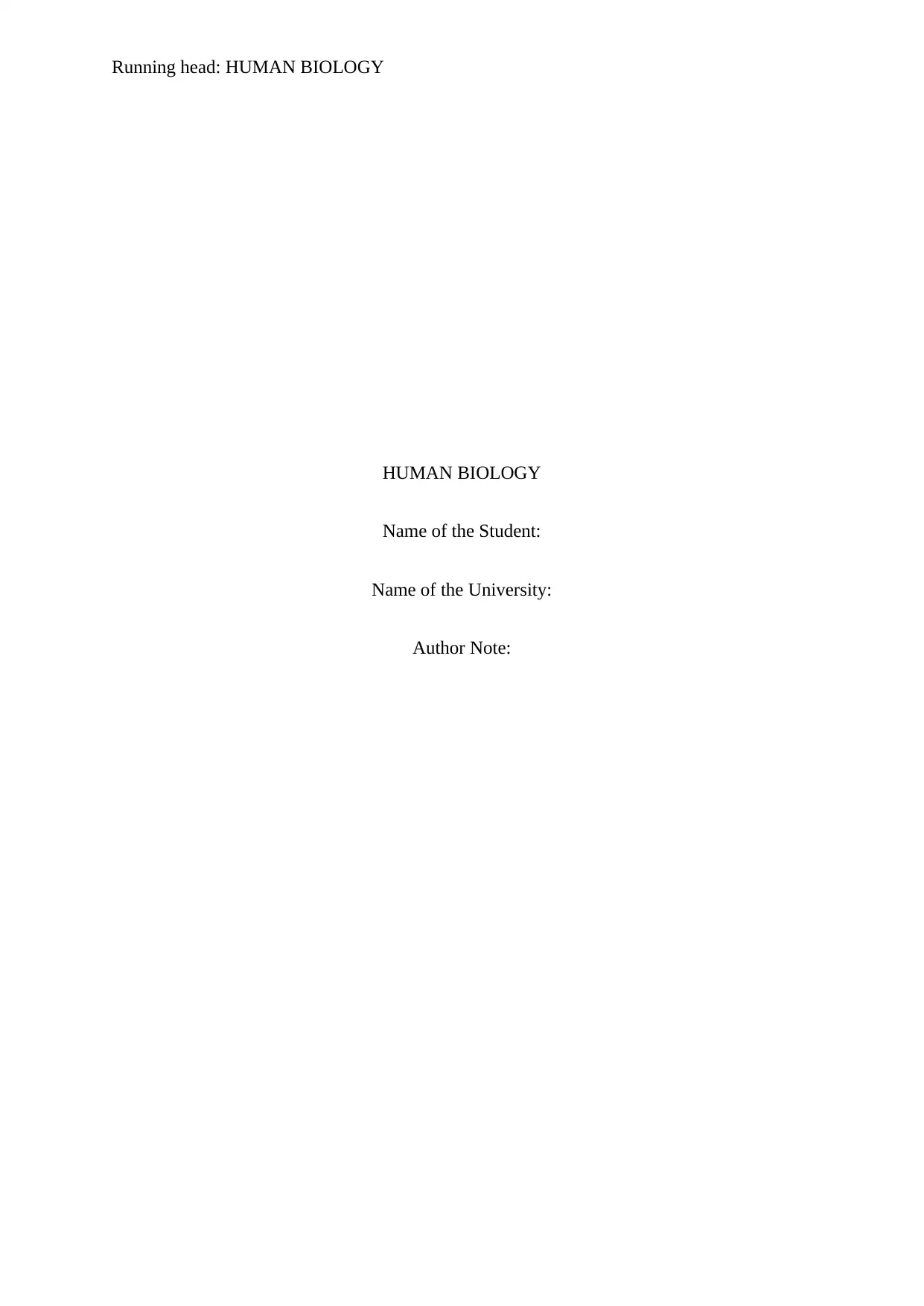
Running head: HUMAN BIOLOGY
HUMAN BIOLOGY
Name of the Student:
Name of the University:
Author Note:
HUMAN BIOLOGY
Name of the Student:
Name of the University:
Author Note:
Secure Best Marks with AI Grader
Need help grading? Try our AI Grader for instant feedback on your assignments.
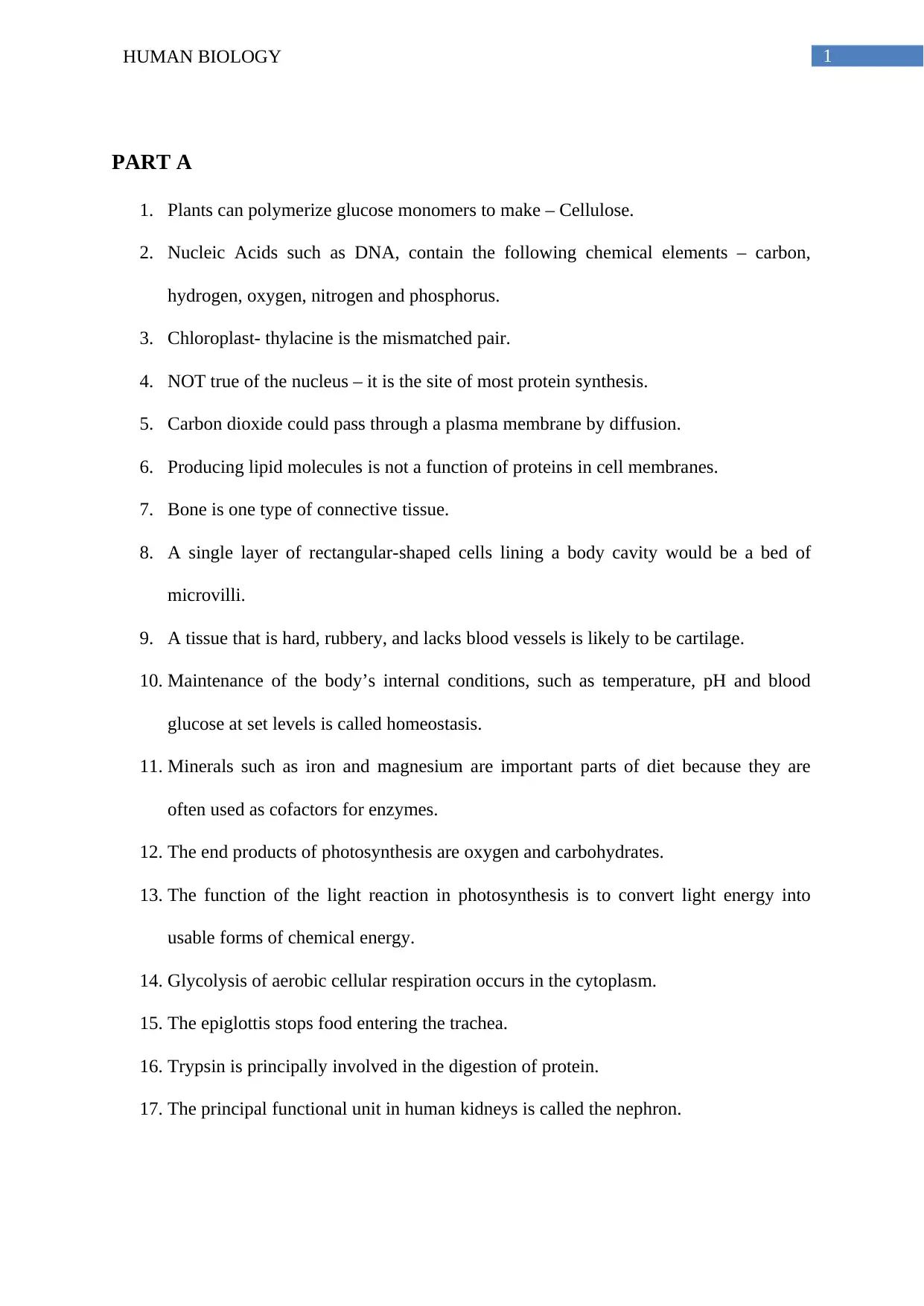
HUMAN BIOLOGY 1
PART A
1. Plants can polymerize glucose monomers to make – Cellulose.
2. Nucleic Acids such as DNA, contain the following chemical elements – carbon,
hydrogen, oxygen, nitrogen and phosphorus.
3. Chloroplast- thylacine is the mismatched pair.
4. NOT true of the nucleus – it is the site of most protein synthesis.
5. Carbon dioxide could pass through a plasma membrane by diffusion.
6. Producing lipid molecules is not a function of proteins in cell membranes.
7. Bone is one type of connective tissue.
8. A single layer of rectangular-shaped cells lining a body cavity would be a bed of
microvilli.
9. A tissue that is hard, rubbery, and lacks blood vessels is likely to be cartilage.
10. Maintenance of the body’s internal conditions, such as temperature, pH and blood
glucose at set levels is called homeostasis.
11. Minerals such as iron and magnesium are important parts of diet because they are
often used as cofactors for enzymes.
12. The end products of photosynthesis are oxygen and carbohydrates.
13. The function of the light reaction in photosynthesis is to convert light energy into
usable forms of chemical energy.
14. Glycolysis of aerobic cellular respiration occurs in the cytoplasm.
15. The epiglottis stops food entering the trachea.
16. Trypsin is principally involved in the digestion of protein.
17. The principal functional unit in human kidneys is called the nephron.
PART A
1. Plants can polymerize glucose monomers to make – Cellulose.
2. Nucleic Acids such as DNA, contain the following chemical elements – carbon,
hydrogen, oxygen, nitrogen and phosphorus.
3. Chloroplast- thylacine is the mismatched pair.
4. NOT true of the nucleus – it is the site of most protein synthesis.
5. Carbon dioxide could pass through a plasma membrane by diffusion.
6. Producing lipid molecules is not a function of proteins in cell membranes.
7. Bone is one type of connective tissue.
8. A single layer of rectangular-shaped cells lining a body cavity would be a bed of
microvilli.
9. A tissue that is hard, rubbery, and lacks blood vessels is likely to be cartilage.
10. Maintenance of the body’s internal conditions, such as temperature, pH and blood
glucose at set levels is called homeostasis.
11. Minerals such as iron and magnesium are important parts of diet because they are
often used as cofactors for enzymes.
12. The end products of photosynthesis are oxygen and carbohydrates.
13. The function of the light reaction in photosynthesis is to convert light energy into
usable forms of chemical energy.
14. Glycolysis of aerobic cellular respiration occurs in the cytoplasm.
15. The epiglottis stops food entering the trachea.
16. Trypsin is principally involved in the digestion of protein.
17. The principal functional unit in human kidneys is called the nephron.
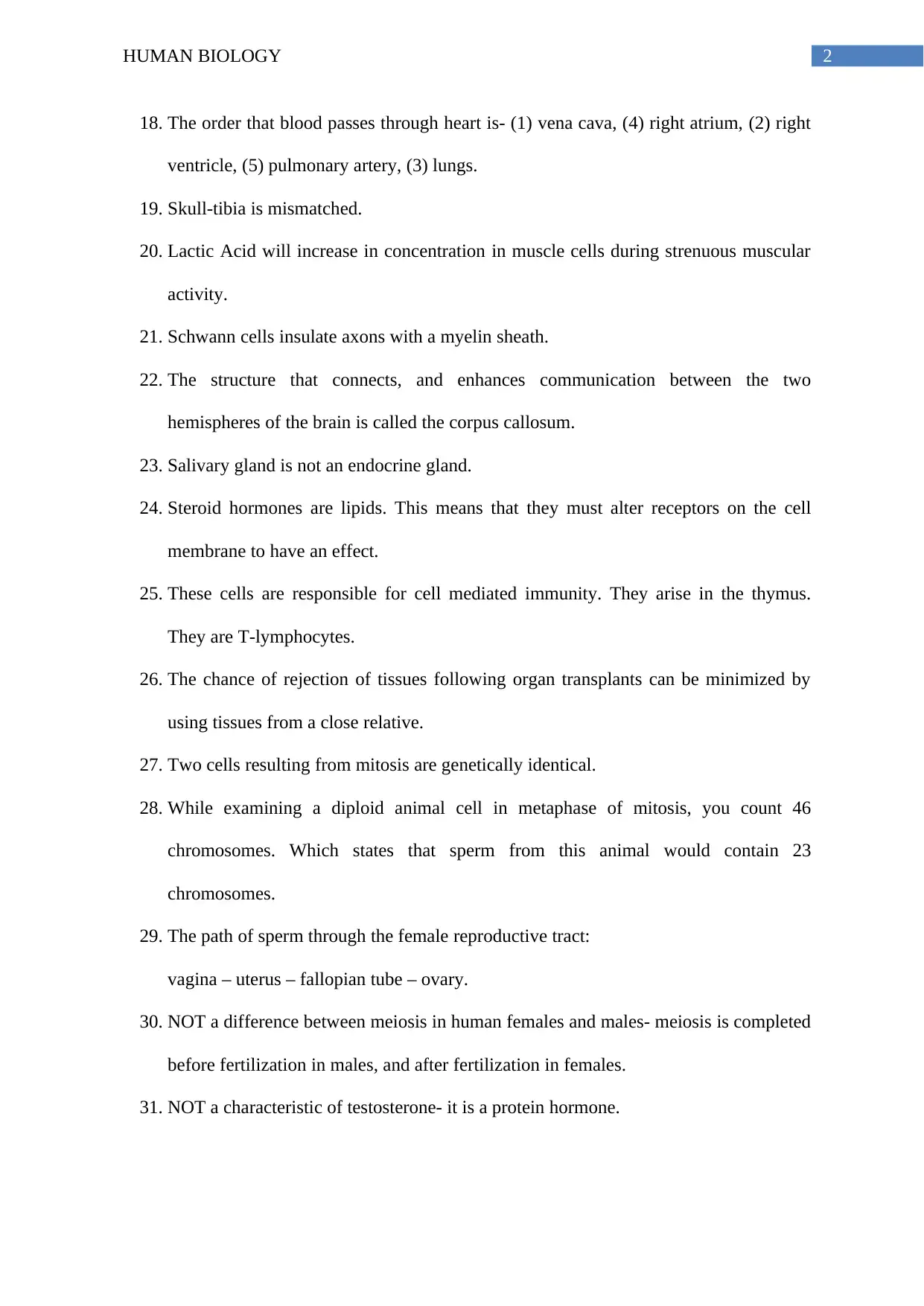
2HUMAN BIOLOGY
18. The order that blood passes through heart is- (1) vena cava, (4) right atrium, (2) right
ventricle, (5) pulmonary artery, (3) lungs.
19. Skull-tibia is mismatched.
20. Lactic Acid will increase in concentration in muscle cells during strenuous muscular
activity.
21. Schwann cells insulate axons with a myelin sheath.
22. The structure that connects, and enhances communication between the two
hemispheres of the brain is called the corpus callosum.
23. Salivary gland is not an endocrine gland.
24. Steroid hormones are lipids. This means that they must alter receptors on the cell
membrane to have an effect.
25. These cells are responsible for cell mediated immunity. They arise in the thymus.
They are T-lymphocytes.
26. The chance of rejection of tissues following organ transplants can be minimized by
using tissues from a close relative.
27. Two cells resulting from mitosis are genetically identical.
28. While examining a diploid animal cell in metaphase of mitosis, you count 46
chromosomes. Which states that sperm from this animal would contain 23
chromosomes.
29. The path of sperm through the female reproductive tract:
vagina – uterus – fallopian tube – ovary.
30. NOT a difference between meiosis in human females and males- meiosis is completed
before fertilization in males, and after fertilization in females.
31. NOT a characteristic of testosterone- it is a protein hormone.
18. The order that blood passes through heart is- (1) vena cava, (4) right atrium, (2) right
ventricle, (5) pulmonary artery, (3) lungs.
19. Skull-tibia is mismatched.
20. Lactic Acid will increase in concentration in muscle cells during strenuous muscular
activity.
21. Schwann cells insulate axons with a myelin sheath.
22. The structure that connects, and enhances communication between the two
hemispheres of the brain is called the corpus callosum.
23. Salivary gland is not an endocrine gland.
24. Steroid hormones are lipids. This means that they must alter receptors on the cell
membrane to have an effect.
25. These cells are responsible for cell mediated immunity. They arise in the thymus.
They are T-lymphocytes.
26. The chance of rejection of tissues following organ transplants can be minimized by
using tissues from a close relative.
27. Two cells resulting from mitosis are genetically identical.
28. While examining a diploid animal cell in metaphase of mitosis, you count 46
chromosomes. Which states that sperm from this animal would contain 23
chromosomes.
29. The path of sperm through the female reproductive tract:
vagina – uterus – fallopian tube – ovary.
30. NOT a difference between meiosis in human females and males- meiosis is completed
before fertilization in males, and after fertilization in females.
31. NOT a characteristic of testosterone- it is a protein hormone.
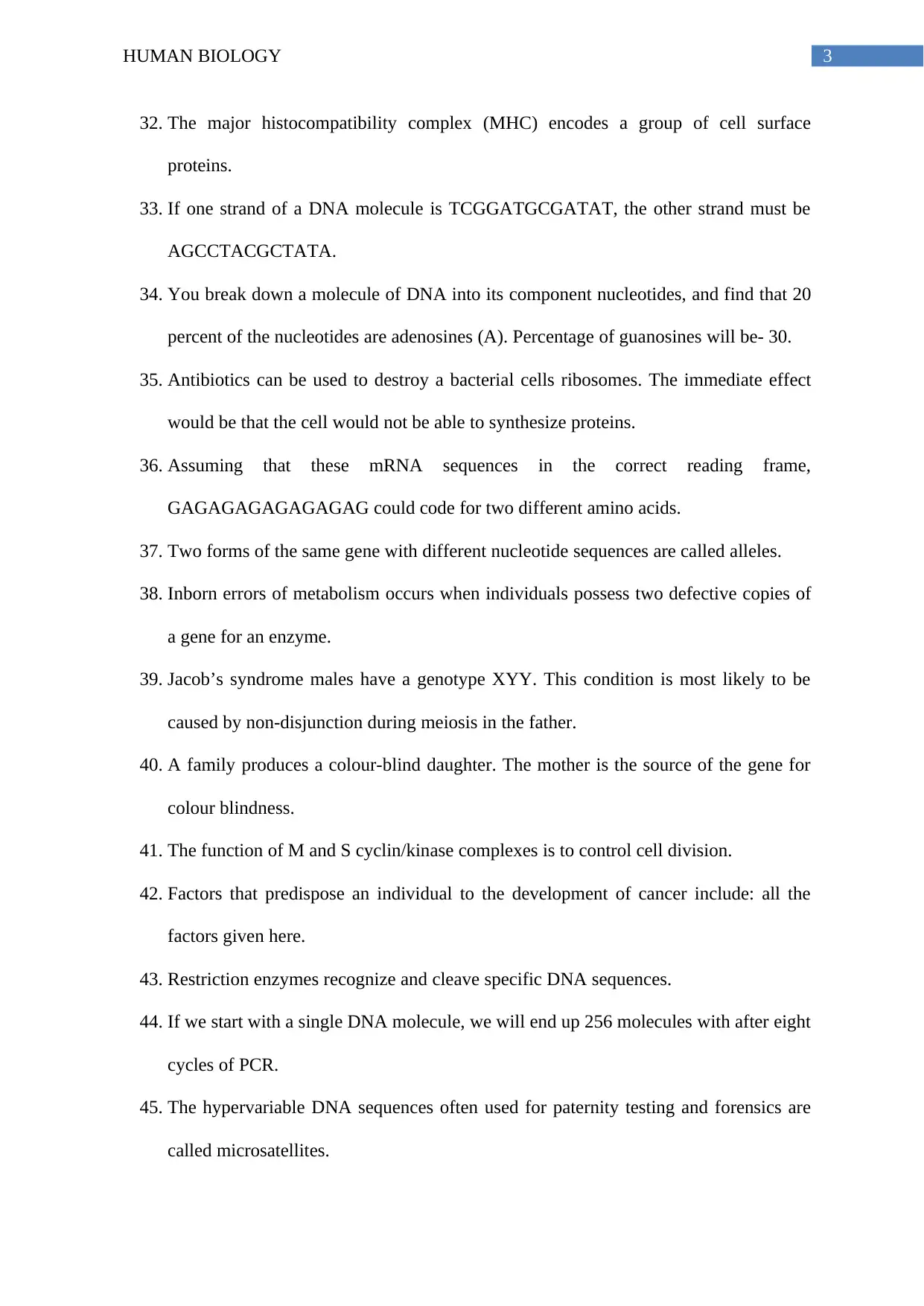
3HUMAN BIOLOGY
32. The major histocompatibility complex (MHC) encodes a group of cell surface
proteins.
33. If one strand of a DNA molecule is TCGGATGCGATAT, the other strand must be
AGCCTACGCTATA.
34. You break down a molecule of DNA into its component nucleotides, and find that 20
percent of the nucleotides are adenosines (A). Percentage of guanosines will be- 30.
35. Antibiotics can be used to destroy a bacterial cells ribosomes. The immediate effect
would be that the cell would not be able to synthesize proteins.
36. Assuming that these mRNA sequences in the correct reading frame,
GAGAGAGAGAGAGAG could code for two different amino acids.
37. Two forms of the same gene with different nucleotide sequences are called alleles.
38. Inborn errors of metabolism occurs when individuals possess two defective copies of
a gene for an enzyme.
39. Jacob’s syndrome males have a genotype XYY. This condition is most likely to be
caused by non-disjunction during meiosis in the father.
40. A family produces a colour-blind daughter. The mother is the source of the gene for
colour blindness.
41. The function of M and S cyclin/kinase complexes is to control cell division.
42. Factors that predispose an individual to the development of cancer include: all the
factors given here.
43. Restriction enzymes recognize and cleave specific DNA sequences.
44. If we start with a single DNA molecule, we will end up 256 molecules with after eight
cycles of PCR.
45. The hypervariable DNA sequences often used for paternity testing and forensics are
called microsatellites.
32. The major histocompatibility complex (MHC) encodes a group of cell surface
proteins.
33. If one strand of a DNA molecule is TCGGATGCGATAT, the other strand must be
AGCCTACGCTATA.
34. You break down a molecule of DNA into its component nucleotides, and find that 20
percent of the nucleotides are adenosines (A). Percentage of guanosines will be- 30.
35. Antibiotics can be used to destroy a bacterial cells ribosomes. The immediate effect
would be that the cell would not be able to synthesize proteins.
36. Assuming that these mRNA sequences in the correct reading frame,
GAGAGAGAGAGAGAG could code for two different amino acids.
37. Two forms of the same gene with different nucleotide sequences are called alleles.
38. Inborn errors of metabolism occurs when individuals possess two defective copies of
a gene for an enzyme.
39. Jacob’s syndrome males have a genotype XYY. This condition is most likely to be
caused by non-disjunction during meiosis in the father.
40. A family produces a colour-blind daughter. The mother is the source of the gene for
colour blindness.
41. The function of M and S cyclin/kinase complexes is to control cell division.
42. Factors that predispose an individual to the development of cancer include: all the
factors given here.
43. Restriction enzymes recognize and cleave specific DNA sequences.
44. If we start with a single DNA molecule, we will end up 256 molecules with after eight
cycles of PCR.
45. The hypervariable DNA sequences often used for paternity testing and forensics are
called microsatellites.
Secure Best Marks with AI Grader
Need help grading? Try our AI Grader for instant feedback on your assignments.
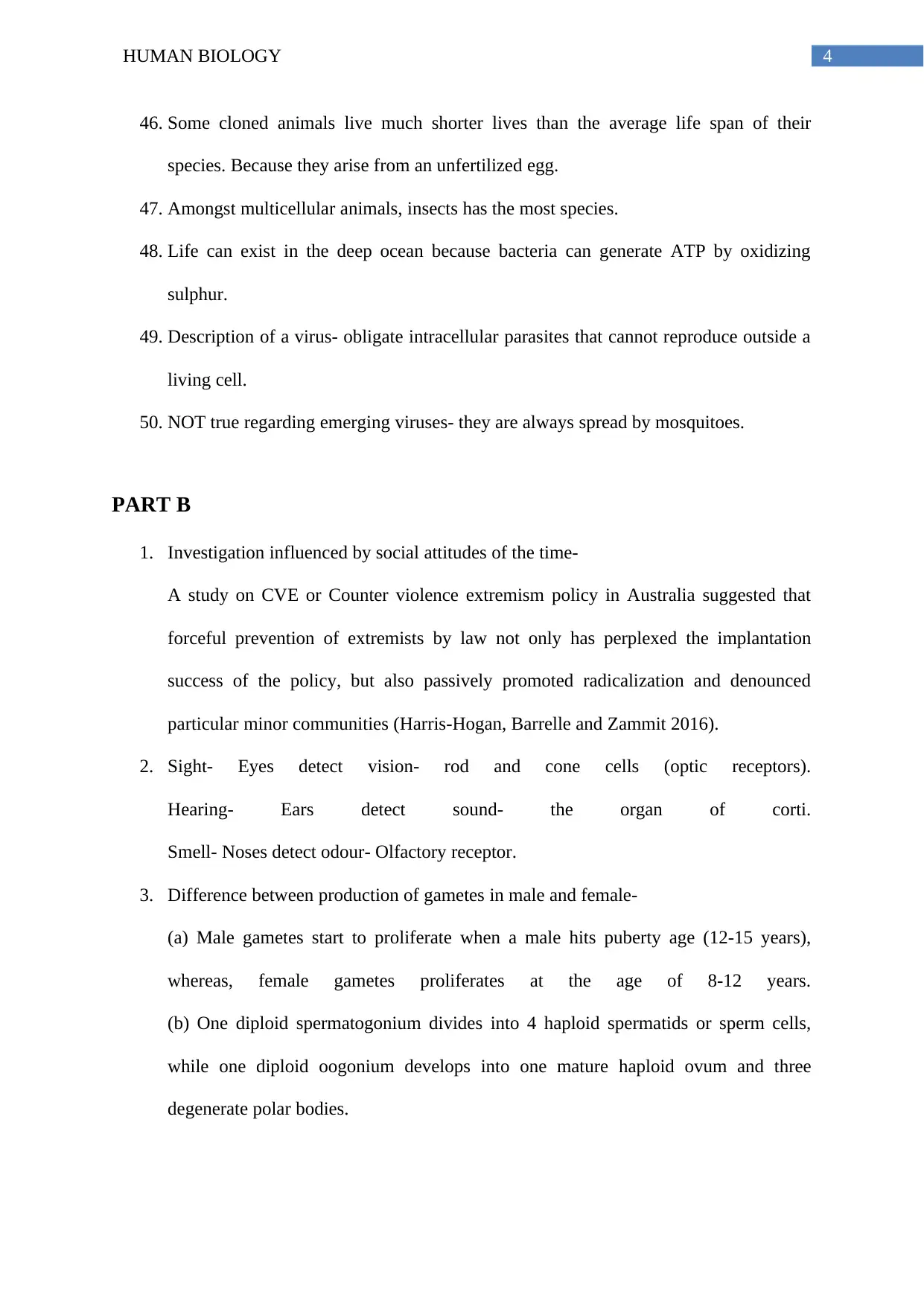
4HUMAN BIOLOGY
46. Some cloned animals live much shorter lives than the average life span of their
species. Because they arise from an unfertilized egg.
47. Amongst multicellular animals, insects has the most species.
48. Life can exist in the deep ocean because bacteria can generate ATP by oxidizing
sulphur.
49. Description of a virus- obligate intracellular parasites that cannot reproduce outside a
living cell.
50. NOT true regarding emerging viruses- they are always spread by mosquitoes.
PART B
1. Investigation influenced by social attitudes of the time-
A study on CVE or Counter violence extremism policy in Australia suggested that
forceful prevention of extremists by law not only has perplexed the implantation
success of the policy, but also passively promoted radicalization and denounced
particular minor communities (Harris-Hogan, Barrelle and Zammit 2016).
2. Sight- Eyes detect vision- rod and cone cells (optic receptors).
Hearing- Ears detect sound- the organ of corti.
Smell- Noses detect odour- Olfactory receptor.
3. Difference between production of gametes in male and female-
(a) Male gametes start to proliferate when a male hits puberty age (12-15 years),
whereas, female gametes proliferates at the age of 8-12 years.
(b) One diploid spermatogonium divides into 4 haploid spermatids or sperm cells,
while one diploid oogonium develops into one mature haploid ovum and three
degenerate polar bodies.
46. Some cloned animals live much shorter lives than the average life span of their
species. Because they arise from an unfertilized egg.
47. Amongst multicellular animals, insects has the most species.
48. Life can exist in the deep ocean because bacteria can generate ATP by oxidizing
sulphur.
49. Description of a virus- obligate intracellular parasites that cannot reproduce outside a
living cell.
50. NOT true regarding emerging viruses- they are always spread by mosquitoes.
PART B
1. Investigation influenced by social attitudes of the time-
A study on CVE or Counter violence extremism policy in Australia suggested that
forceful prevention of extremists by law not only has perplexed the implantation
success of the policy, but also passively promoted radicalization and denounced
particular minor communities (Harris-Hogan, Barrelle and Zammit 2016).
2. Sight- Eyes detect vision- rod and cone cells (optic receptors).
Hearing- Ears detect sound- the organ of corti.
Smell- Noses detect odour- Olfactory receptor.
3. Difference between production of gametes in male and female-
(a) Male gametes start to proliferate when a male hits puberty age (12-15 years),
whereas, female gametes proliferates at the age of 8-12 years.
(b) One diploid spermatogonium divides into 4 haploid spermatids or sperm cells,
while one diploid oogonium develops into one mature haploid ovum and three
degenerate polar bodies.
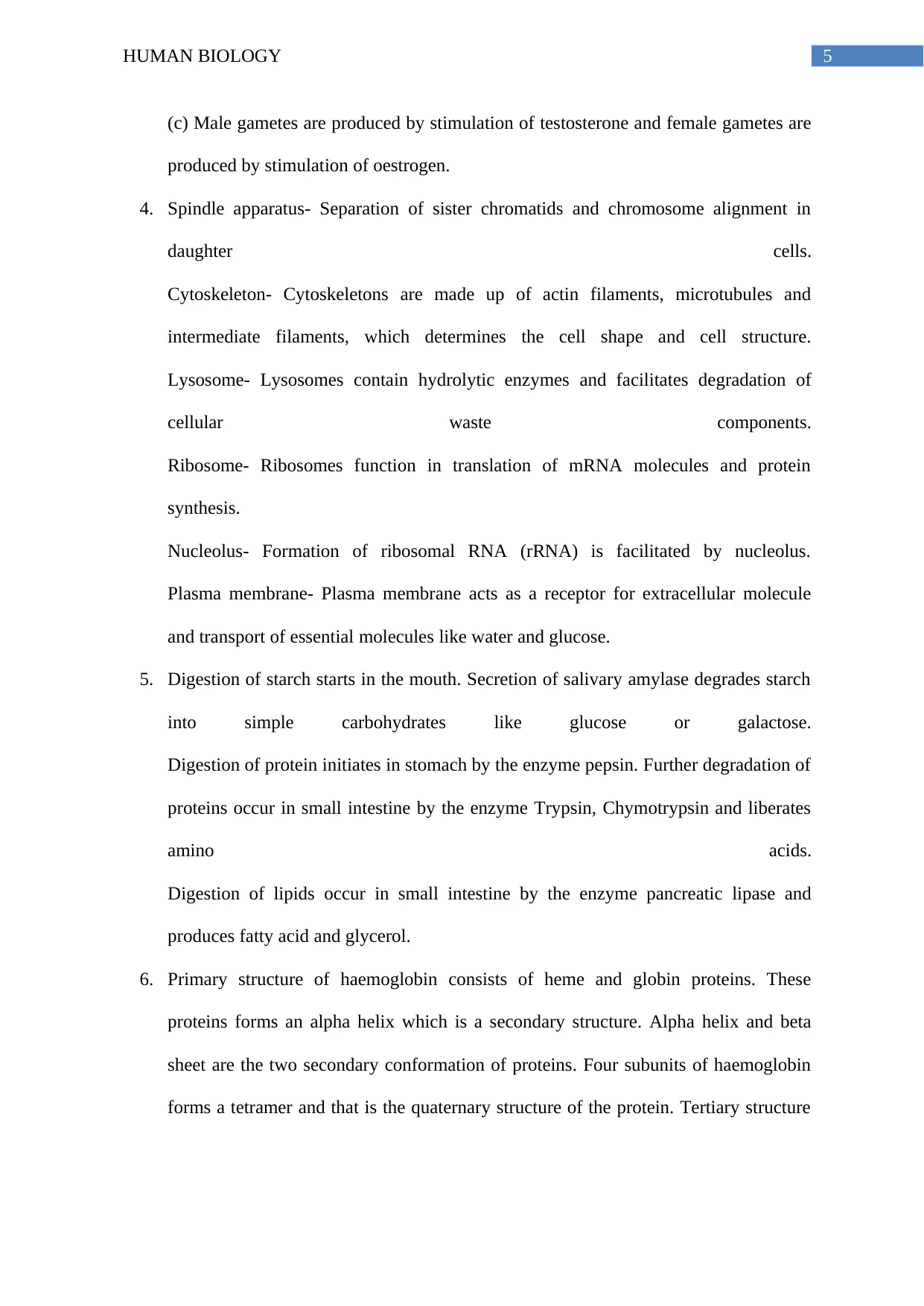
5HUMAN BIOLOGY
(c) Male gametes are produced by stimulation of testosterone and female gametes are
produced by stimulation of oestrogen.
4. Spindle apparatus- Separation of sister chromatids and chromosome alignment in
daughter cells.
Cytoskeleton- Cytoskeletons are made up of actin filaments, microtubules and
intermediate filaments, which determines the cell shape and cell structure.
Lysosome- Lysosomes contain hydrolytic enzymes and facilitates degradation of
cellular waste components.
Ribosome- Ribosomes function in translation of mRNA molecules and protein
synthesis.
Nucleolus- Formation of ribosomal RNA (rRNA) is facilitated by nucleolus.
Plasma membrane- Plasma membrane acts as a receptor for extracellular molecule
and transport of essential molecules like water and glucose.
5. Digestion of starch starts in the mouth. Secretion of salivary amylase degrades starch
into simple carbohydrates like glucose or galactose.
Digestion of protein initiates in stomach by the enzyme pepsin. Further degradation of
proteins occur in small intestine by the enzyme Trypsin, Chymotrypsin and liberates
amino acids.
Digestion of lipids occur in small intestine by the enzyme pancreatic lipase and
produces fatty acid and glycerol.
6. Primary structure of haemoglobin consists of heme and globin proteins. These
proteins forms an alpha helix which is a secondary structure. Alpha helix and beta
sheet are the two secondary conformation of proteins. Four subunits of haemoglobin
forms a tetramer and that is the quaternary structure of the protein. Tertiary structure
(c) Male gametes are produced by stimulation of testosterone and female gametes are
produced by stimulation of oestrogen.
4. Spindle apparatus- Separation of sister chromatids and chromosome alignment in
daughter cells.
Cytoskeleton- Cytoskeletons are made up of actin filaments, microtubules and
intermediate filaments, which determines the cell shape and cell structure.
Lysosome- Lysosomes contain hydrolytic enzymes and facilitates degradation of
cellular waste components.
Ribosome- Ribosomes function in translation of mRNA molecules and protein
synthesis.
Nucleolus- Formation of ribosomal RNA (rRNA) is facilitated by nucleolus.
Plasma membrane- Plasma membrane acts as a receptor for extracellular molecule
and transport of essential molecules like water and glucose.
5. Digestion of starch starts in the mouth. Secretion of salivary amylase degrades starch
into simple carbohydrates like glucose or galactose.
Digestion of protein initiates in stomach by the enzyme pepsin. Further degradation of
proteins occur in small intestine by the enzyme Trypsin, Chymotrypsin and liberates
amino acids.
Digestion of lipids occur in small intestine by the enzyme pancreatic lipase and
produces fatty acid and glycerol.
6. Primary structure of haemoglobin consists of heme and globin proteins. These
proteins forms an alpha helix which is a secondary structure. Alpha helix and beta
sheet are the two secondary conformation of proteins. Four subunits of haemoglobin
forms a tetramer and that is the quaternary structure of the protein. Tertiary structure

6HUMAN BIOLOGY
of haemoglobin is an intermediate conformation between secondary and quaternary
structure.
7. Some biological reaction requires a lot of energy to convert a substrate into a product,
hence the activation energy is very high. To overcome this huge energy requirement
enzymes act as catalyst to lower the activation energy and facilitate the reaction in
forward direction.
8. Eukaryotic cells arose from prokaryotic cells as they have organelles which are
membrane bound like mitochondria, chloroplast, and these organelles also have self-
DNA which are not dependent on the nuclear chromosomes. It has its own replicative
mechanisms and more than 90 percent ancestral homology have been found with
alpha protobacteria (for mitochondria) and cyanobacteria (for chloroplast). These
evidences strongly suggests the endosymbiotic theory of evolution implying that
earlier these organelles were independent prokaryotic bacteria, which incorporated
themselves into one another in a symbiotic association.
9. Iron or Fe molecules are an essential component of haemoglobin as they are
absolutely required for binding of oxygen with the help of two histidine molecules,
proximal and distal histidine.
Carbohydrates are a ready source of energy, i.e. ATP, which are produced by
glycolysis in the cytosol. The end product of glycolysis is NADPH and pyruvate.
Pyruvate then converts into acetyl CoA, that travels inside mitochondria and passes
through Krebs Cycle to generate more NADPH and FADH2. NADPH and FADH2 are
the primary electron carriers that transport through electron transport chain and
facilitates the production of ATP.
Vitamin B1 or thiamin diphosphate is the essential compound required as a coenzyme
for decarboxylation of alpha ketoglutarate by alpha ketoglutarate dehydrogenase
of haemoglobin is an intermediate conformation between secondary and quaternary
structure.
7. Some biological reaction requires a lot of energy to convert a substrate into a product,
hence the activation energy is very high. To overcome this huge energy requirement
enzymes act as catalyst to lower the activation energy and facilitate the reaction in
forward direction.
8. Eukaryotic cells arose from prokaryotic cells as they have organelles which are
membrane bound like mitochondria, chloroplast, and these organelles also have self-
DNA which are not dependent on the nuclear chromosomes. It has its own replicative
mechanisms and more than 90 percent ancestral homology have been found with
alpha protobacteria (for mitochondria) and cyanobacteria (for chloroplast). These
evidences strongly suggests the endosymbiotic theory of evolution implying that
earlier these organelles were independent prokaryotic bacteria, which incorporated
themselves into one another in a symbiotic association.
9. Iron or Fe molecules are an essential component of haemoglobin as they are
absolutely required for binding of oxygen with the help of two histidine molecules,
proximal and distal histidine.
Carbohydrates are a ready source of energy, i.e. ATP, which are produced by
glycolysis in the cytosol. The end product of glycolysis is NADPH and pyruvate.
Pyruvate then converts into acetyl CoA, that travels inside mitochondria and passes
through Krebs Cycle to generate more NADPH and FADH2. NADPH and FADH2 are
the primary electron carriers that transport through electron transport chain and
facilitates the production of ATP.
Vitamin B1 or thiamin diphosphate is the essential compound required as a coenzyme
for decarboxylation of alpha ketoglutarate by alpha ketoglutarate dehydrogenase
Paraphrase This Document
Need a fresh take? Get an instant paraphrase of this document with our AI Paraphraser
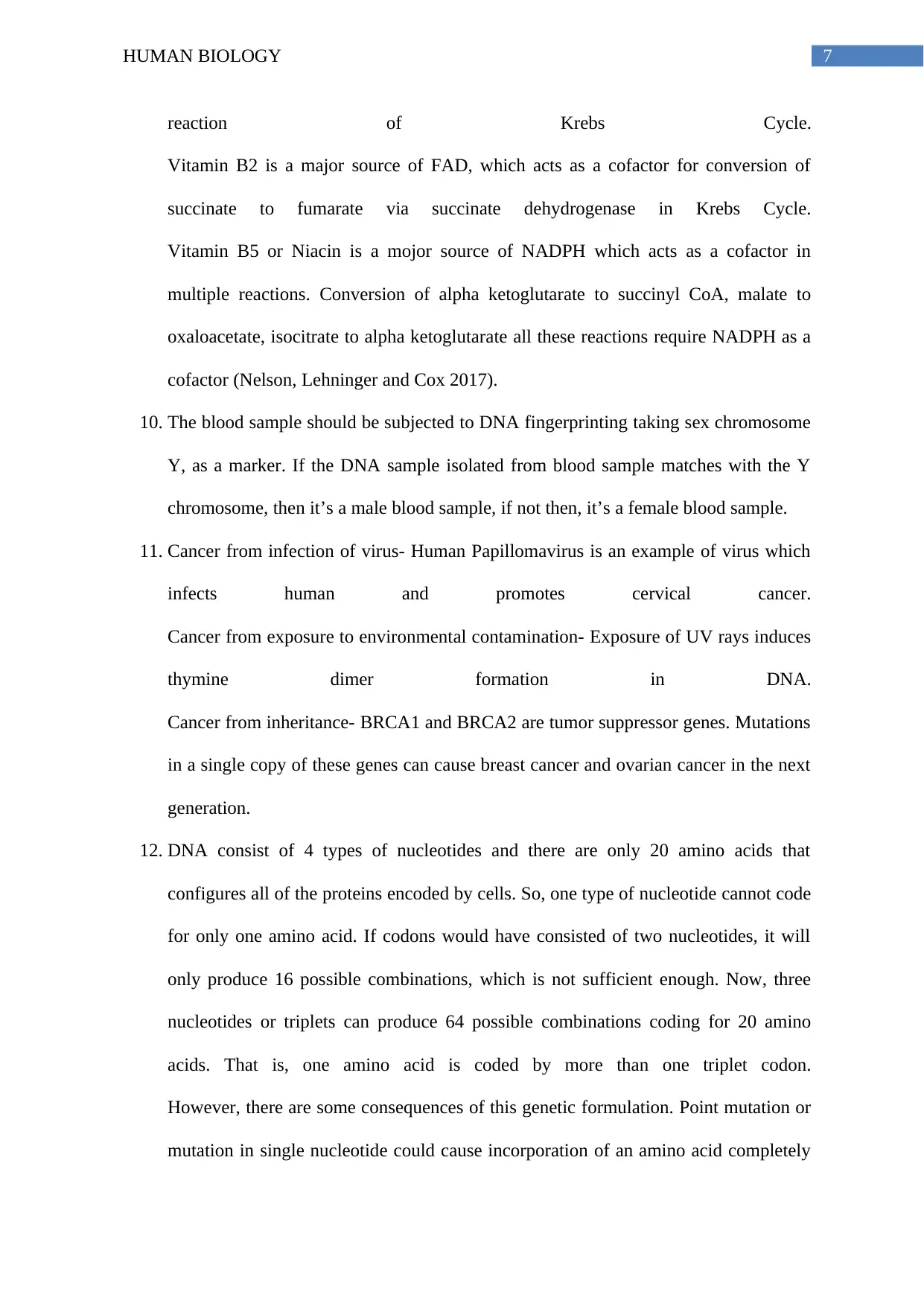
7HUMAN BIOLOGY
reaction of Krebs Cycle.
Vitamin B2 is a major source of FAD, which acts as a cofactor for conversion of
succinate to fumarate via succinate dehydrogenase in Krebs Cycle.
Vitamin B5 or Niacin is a mojor source of NADPH which acts as a cofactor in
multiple reactions. Conversion of alpha ketoglutarate to succinyl CoA, malate to
oxaloacetate, isocitrate to alpha ketoglutarate all these reactions require NADPH as a
cofactor (Nelson, Lehninger and Cox 2017).
10. The blood sample should be subjected to DNA fingerprinting taking sex chromosome
Y, as a marker. If the DNA sample isolated from blood sample matches with the Y
chromosome, then it’s a male blood sample, if not then, it’s a female blood sample.
11. Cancer from infection of virus- Human Papillomavirus is an example of virus which
infects human and promotes cervical cancer.
Cancer from exposure to environmental contamination- Exposure of UV rays induces
thymine dimer formation in DNA.
Cancer from inheritance- BRCA1 and BRCA2 are tumor suppressor genes. Mutations
in a single copy of these genes can cause breast cancer and ovarian cancer in the next
generation.
12. DNA consist of 4 types of nucleotides and there are only 20 amino acids that
configures all of the proteins encoded by cells. So, one type of nucleotide cannot code
for only one amino acid. If codons would have consisted of two nucleotides, it will
only produce 16 possible combinations, which is not sufficient enough. Now, three
nucleotides or triplets can produce 64 possible combinations coding for 20 amino
acids. That is, one amino acid is coded by more than one triplet codon.
However, there are some consequences of this genetic formulation. Point mutation or
mutation in single nucleotide could cause incorporation of an amino acid completely
reaction of Krebs Cycle.
Vitamin B2 is a major source of FAD, which acts as a cofactor for conversion of
succinate to fumarate via succinate dehydrogenase in Krebs Cycle.
Vitamin B5 or Niacin is a mojor source of NADPH which acts as a cofactor in
multiple reactions. Conversion of alpha ketoglutarate to succinyl CoA, malate to
oxaloacetate, isocitrate to alpha ketoglutarate all these reactions require NADPH as a
cofactor (Nelson, Lehninger and Cox 2017).
10. The blood sample should be subjected to DNA fingerprinting taking sex chromosome
Y, as a marker. If the DNA sample isolated from blood sample matches with the Y
chromosome, then it’s a male blood sample, if not then, it’s a female blood sample.
11. Cancer from infection of virus- Human Papillomavirus is an example of virus which
infects human and promotes cervical cancer.
Cancer from exposure to environmental contamination- Exposure of UV rays induces
thymine dimer formation in DNA.
Cancer from inheritance- BRCA1 and BRCA2 are tumor suppressor genes. Mutations
in a single copy of these genes can cause breast cancer and ovarian cancer in the next
generation.
12. DNA consist of 4 types of nucleotides and there are only 20 amino acids that
configures all of the proteins encoded by cells. So, one type of nucleotide cannot code
for only one amino acid. If codons would have consisted of two nucleotides, it will
only produce 16 possible combinations, which is not sufficient enough. Now, three
nucleotides or triplets can produce 64 possible combinations coding for 20 amino
acids. That is, one amino acid is coded by more than one triplet codon.
However, there are some consequences of this genetic formulation. Point mutation or
mutation in single nucleotide could cause incorporation of an amino acid completely
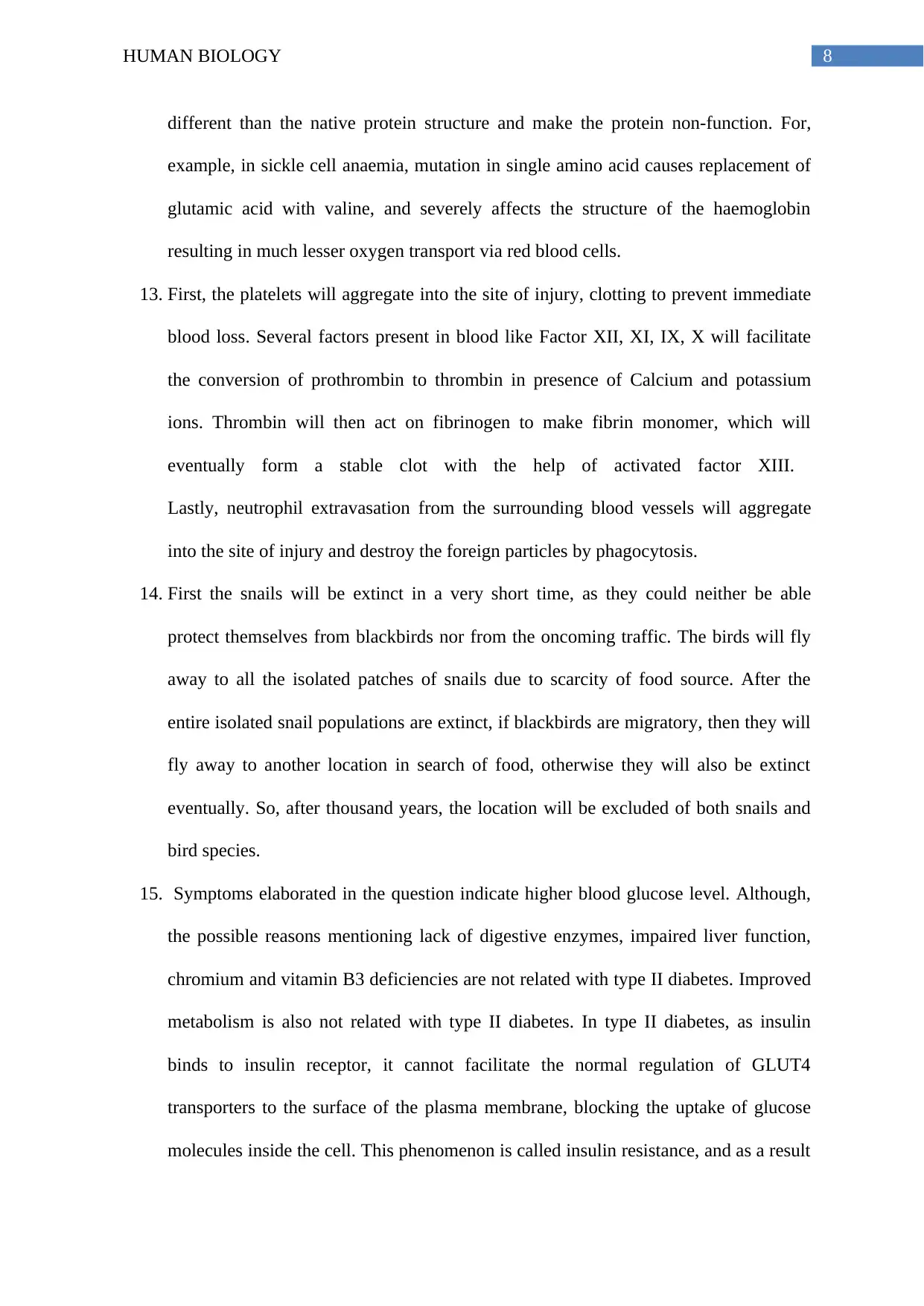
8HUMAN BIOLOGY
different than the native protein structure and make the protein non-function. For,
example, in sickle cell anaemia, mutation in single amino acid causes replacement of
glutamic acid with valine, and severely affects the structure of the haemoglobin
resulting in much lesser oxygen transport via red blood cells.
13. First, the platelets will aggregate into the site of injury, clotting to prevent immediate
blood loss. Several factors present in blood like Factor XII, XI, IX, X will facilitate
the conversion of prothrombin to thrombin in presence of Calcium and potassium
ions. Thrombin will then act on fibrinogen to make fibrin monomer, which will
eventually form a stable clot with the help of activated factor XIII.
Lastly, neutrophil extravasation from the surrounding blood vessels will aggregate
into the site of injury and destroy the foreign particles by phagocytosis.
14. First the snails will be extinct in a very short time, as they could neither be able
protect themselves from blackbirds nor from the oncoming traffic. The birds will fly
away to all the isolated patches of snails due to scarcity of food source. After the
entire isolated snail populations are extinct, if blackbirds are migratory, then they will
fly away to another location in search of food, otherwise they will also be extinct
eventually. So, after thousand years, the location will be excluded of both snails and
bird species.
15. Symptoms elaborated in the question indicate higher blood glucose level. Although,
the possible reasons mentioning lack of digestive enzymes, impaired liver function,
chromium and vitamin B3 deficiencies are not related with type II diabetes. Improved
metabolism is also not related with type II diabetes. In type II diabetes, as insulin
binds to insulin receptor, it cannot facilitate the normal regulation of GLUT4
transporters to the surface of the plasma membrane, blocking the uptake of glucose
molecules inside the cell. This phenomenon is called insulin resistance, and as a result
different than the native protein structure and make the protein non-function. For,
example, in sickle cell anaemia, mutation in single amino acid causes replacement of
glutamic acid with valine, and severely affects the structure of the haemoglobin
resulting in much lesser oxygen transport via red blood cells.
13. First, the platelets will aggregate into the site of injury, clotting to prevent immediate
blood loss. Several factors present in blood like Factor XII, XI, IX, X will facilitate
the conversion of prothrombin to thrombin in presence of Calcium and potassium
ions. Thrombin will then act on fibrinogen to make fibrin monomer, which will
eventually form a stable clot with the help of activated factor XIII.
Lastly, neutrophil extravasation from the surrounding blood vessels will aggregate
into the site of injury and destroy the foreign particles by phagocytosis.
14. First the snails will be extinct in a very short time, as they could neither be able
protect themselves from blackbirds nor from the oncoming traffic. The birds will fly
away to all the isolated patches of snails due to scarcity of food source. After the
entire isolated snail populations are extinct, if blackbirds are migratory, then they will
fly away to another location in search of food, otherwise they will also be extinct
eventually. So, after thousand years, the location will be excluded of both snails and
bird species.
15. Symptoms elaborated in the question indicate higher blood glucose level. Although,
the possible reasons mentioning lack of digestive enzymes, impaired liver function,
chromium and vitamin B3 deficiencies are not related with type II diabetes. Improved
metabolism is also not related with type II diabetes. In type II diabetes, as insulin
binds to insulin receptor, it cannot facilitate the normal regulation of GLUT4
transporters to the surface of the plasma membrane, blocking the uptake of glucose
molecules inside the cell. This phenomenon is called insulin resistance, and as a result
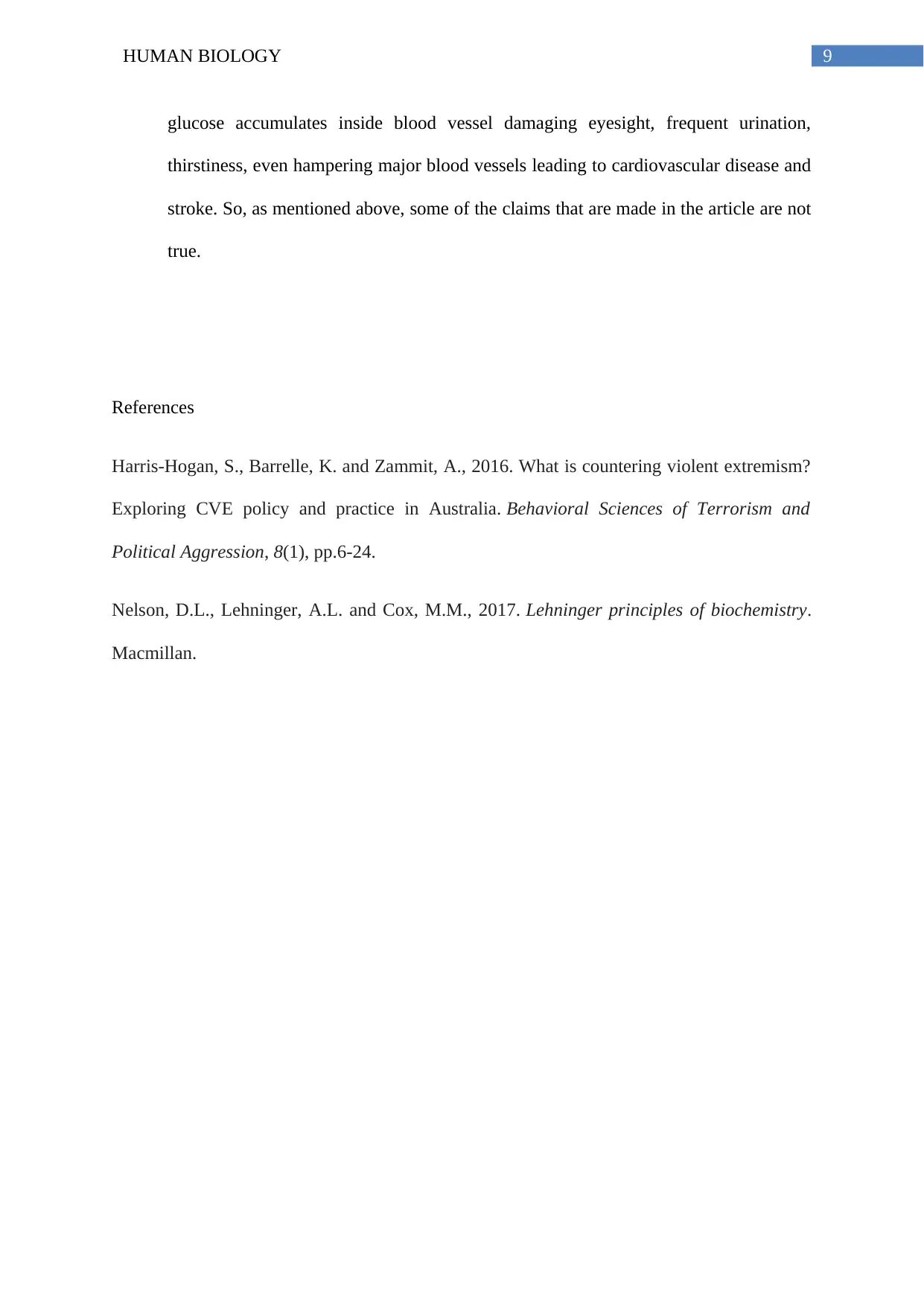
9HUMAN BIOLOGY
glucose accumulates inside blood vessel damaging eyesight, frequent urination,
thirstiness, even hampering major blood vessels leading to cardiovascular disease and
stroke. So, as mentioned above, some of the claims that are made in the article are not
true.
References
Harris-Hogan, S., Barrelle, K. and Zammit, A., 2016. What is countering violent extremism?
Exploring CVE policy and practice in Australia. Behavioral Sciences of Terrorism and
Political Aggression, 8(1), pp.6-24.
Nelson, D.L., Lehninger, A.L. and Cox, M.M., 2017. Lehninger principles of biochemistry.
Macmillan.
glucose accumulates inside blood vessel damaging eyesight, frequent urination,
thirstiness, even hampering major blood vessels leading to cardiovascular disease and
stroke. So, as mentioned above, some of the claims that are made in the article are not
true.
References
Harris-Hogan, S., Barrelle, K. and Zammit, A., 2016. What is countering violent extremism?
Exploring CVE policy and practice in Australia. Behavioral Sciences of Terrorism and
Political Aggression, 8(1), pp.6-24.
Nelson, D.L., Lehninger, A.L. and Cox, M.M., 2017. Lehninger principles of biochemistry.
Macmillan.
1 out of 10
Related Documents
Your All-in-One AI-Powered Toolkit for Academic Success.
+13062052269
info@desklib.com
Available 24*7 on WhatsApp / Email
![[object Object]](/_next/static/media/star-bottom.7253800d.svg)
Unlock your academic potential
© 2024 | Zucol Services PVT LTD | All rights reserved.




